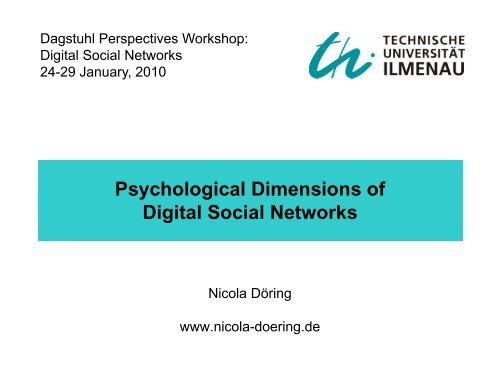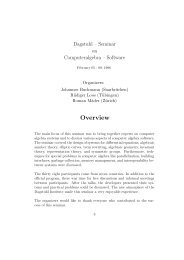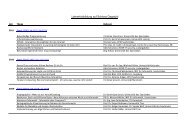Relationship Management
Relationship Management
Relationship Management
Create successful ePaper yourself
Turn your PDF publications into a flip-book with our unique Google optimized e-Paper software.
Dagstuhl Perspectives Workshop:<br />
Digital Social Networks<br />
24-29 January, 2010<br />
Psychological Dimensions of<br />
Digital Social Networks<br />
Nicola Döring<br />
www.nicola-doering.de
Ilmenau University of Technology<br />
Institut für Medien und Kommunikationswissenschaft<br />
www.ifmk.de<br />
Media Design / Media Psychology
Internet Psychology<br />
Research Object<br />
- online (& offline) behaviors and experiences<br />
- of individual internet users (and groups)<br />
- embedded in social contexts<br />
Research Perspective<br />
• Rejection of Media/Technology Determinism<br />
(„what media/technologies do to people“)<br />
• Affirmation of Active Audiences / Active Media Users<br />
(„what people do with media/technologies“)<br />
Theories of Action
Internet Psychology<br />
Basic Research<br />
- Understanding/explaining online behaviors and<br />
experiences by developing new psychological theories<br />
- Online behaviors and experiences as testbed<br />
for established psychological theories<br />
Applied Research<br />
• Psychological input for fostering media literacy<br />
(reducing digital inequalities)<br />
• Psychological input for critical analysis of public discourses<br />
about media innovations<br />
• Psychological input for human-centered media development
Research Methods in<br />
Internet Psychology<br />
Offline Data Collection<br />
(quantitative & qualitative)<br />
Online Data Collection<br />
(quantitative & qualitative)<br />
Non-Experimental<br />
Studies:<br />
- Survey Paper Questionnaire Online Questionnaire<br />
- Interview Oral Interviews<br />
Focus Groups<br />
- Observation Observation in Offline<br />
Contexts<br />
- Document Analysis Analysis of Offline<br />
Documents<br />
Experimental<br />
Study<br />
Case<br />
Study<br />
Online Interviews<br />
Field Observation in Online<br />
Contexts<br />
Analysis of Online<br />
Documents<br />
Laboratory Experiment Online Experiment<br />
Extensive Offline and/or Online Data Collection<br />
5
Population-Representative Surveys of Online Behavior<br />
Germany:<br />
- ARD/ZDF-Online-Studie ARD/ZDF<br />
- KIM-Studie Medienpädagogischer Forschungsverbund Südwest<br />
- JIM-Studie Medienpädagogischer Forschungsverbund Südwest<br />
USA:<br />
- PEW Internet & American Life<br />
6
Weekly Web 2.0-Use in % (14 to 29 years old)<br />
ARD/ZDF-Onlinestudie 2009<br />
Professional SNS<br />
SNS<br />
7
SNS Usage by University Students 2010 (1st Semester)<br />
23,1<br />
Frequency of usage in percent (N=114)<br />
9,1<br />
3,2<br />
58,7<br />
several times a day<br />
once a day<br />
several times a week<br />
more seldom<br />
9
oyd, d. m., & Ellison, N. B. (2007).<br />
Social network sites: Definition, history, and scholarship.<br />
Journal of Computer-Mediated Communication, 13(1), article 11.<br />
http://jcmc.indiana.edu/vol13/issue1/boyd.ellison.html<br />
Definition:<br />
We define social network sites as web-based services that<br />
allow individuals to<br />
(1) construct a public or semi-public profile within a bounded<br />
system,<br />
(2) articulate a list of other users with whom they share a<br />
connection, and<br />
(3) view and traverse their list of connections and those<br />
made by others within the system.<br />
The nature and nomenclature of these connections may<br />
vary from site to site.
Identity <strong>Management</strong><br />
Online Profile<br />
Privacy Settings<br />
Use of Multiple Platforms<br />
Psychological Research on SNS<br />
<strong>Relationship</strong> <strong>Management</strong><br />
List of Friends<br />
Social Network Structure<br />
Interpersonal SNS Behavior
Identity <strong>Management</strong><br />
Self Presentation on SNS Profiles:<br />
a) mostly authentic demographic information (name, age, gender, location etc.)<br />
b) implicit rather than explicit identity claims („show rather than tell“)<br />
group and consumer identities (friends, tastes, fandom, brands etc.)<br />
c) both self-produced and re-used artefacts (status updates, photos, videos etc.)
Identity <strong>Management</strong><br />
Self Presentation on SNS Profiles:<br />
a) mostly authentic demographic information (name, age, gender, location etc.)<br />
b) implicit rather than explicit identity claims („show rather than tell“)<br />
group and consumer identities (friends, tastes, fandom, brands etc.)<br />
c) both self-produced and re-used artefacts (status updates, photos, videos etc.)<br />
Identity Work (self-directed implications of SNS self presentation)<br />
- reflection/affirmation of different aspects of self<br />
- opportunities of identity de-marginalization<br />
Impression Formation (other-directed implications of SNS self presentation)<br />
- successful/unsuccessful self presentation (e.g. attractive, likable, competent)<br />
- differences/similarities between online and offline impressions (e.g. personality)<br />
- privacy issues (privacy settings, multiple separated profiles,<br />
online-reputation management, expiration dates for digital documents)
New Yorker, 1997<br />
2009
<strong>Relationship</strong> <strong>Management</strong><br />
List of Friends:<br />
a) number of „SNS friends“<br />
b) relationship types („SNS friends“ ≠ friendship)<br />
c) social network structure
Number and types of StudiVZ friends<br />
(University Students 2010, 1st Semester)<br />
20
<strong>Relationship</strong> <strong>Management</strong><br />
List of Friends:<br />
a) number of „SNS friends“<br />
b) relationship types („SNS friends“ ≠ friendship)<br />
c) social network structure<br />
Social Integration and Social Capital<br />
- Maintained Social Capital (members of previously inhabited community)<br />
- Bridging Social Capital (weak ties)<br />
- Bonding Social Capital (strong ties)<br />
<strong>Relationship</strong> Formation, Maintenance, Termination<br />
- Interpersonal SNS Behavior<br />
- Social Norms regarding SNS friendship requests<br />
- Experience of Online Social Presence
Media Use in a Close „Real“ Friendship<br />
(University Students 2010, 1st Semester)<br />
23
Psychological Research on SNS<br />
Identity <strong>Management</strong> <strong>Relationship</strong> <strong>Management</strong><br />
Basic Research<br />
- Testing new and established psychological theories<br />
Different Empirical Research Methods<br />
Applied Research<br />
• Psychological input for fostering media literacy<br />
(reducing digital inequalities)<br />
• Psychological input for critical analysis of public<br />
discourses about media innovations<br />
• Psychological input for human-centered media<br />
development
References<br />
relevant journals:<br />
- Journal of Computer Mediated Communication JCMC<br />
- Computers in Human Behavior
Identity management through SNS<br />
boyd, d. (2004). Friendster and Publicly Articulated Social Networks. Conference on Human Factors and Computing Systems<br />
(CHI 2004). Vienna: ACM, April 24-29, 2004.<br />
boyd, d. (2007). Why Youth (Heart) Social Network Sites: The Role of Networked Publics in Teenage Social Life. In:<br />
Buckingham, David (2007): Youth, Identity, and Digital Media, Seite 119-142. Cambridge, MIT Press<br />
boyd, d. (2008). Taken Out of Context. American Teen Sociality in Networkes Publics. Dissertation zur Erlangung des Grades<br />
eines Doktors der Philosophie. Online im Internet: http://www.danah.org/papers/TakenOutOfContext.pdf<br />
boyd, d. & Ellison, N. (2007). "Social Network Sites: Definition, History, and Scholarship." Journal of Computer-Mediated<br />
Communication, 13 (1)<br />
Döring, N. (2003). Sozialpsychologie des Internet. Die Bedeutung des Internet für Kommunikationsprozesse, Identitäten,<br />
soziale Beziehungen und Gruppen. 2. Auflage. Göttingen, Hogrefe.<br />
Goffman, E. (2003). Wir alle spielen Theater. Selbstdarstellung im Alltag. München, Piper.<br />
Ito, M. et al. (2008). Living and Learning with New Media: Summary of Findings from the Digital Youth Project. The John D.<br />
and Catherine T. MacArthur Foundation Reports on Digital Media and Learning. Online im Internet:<br />
http://digitalyouth.ischool.berkeley.edu/report<br />
Mummendey, H. D. (1995). Psychologie der Selbstdarstellung. 2. Auflage. Göttingen, Hogrefe<br />
Prommer, E.; Brücks, A.; Mehnert, J.; Neumann, H.; Räder, A. & Roßland, F. (2009). „Real life extension“ in Web-basierten<br />
sozialen Netzwerken. Eine Studie zur Selbstrepräsentation von Studierenden in studiVZ. Forschungsbericht.<br />
http://www.hff-potsdam.de/fileadmin/hff/dokumente/aktuelles/Medienwiss_Forschungsbericht_studivz.pdf<br />
Skog, D. (2005). Social interaction in virtual communities: the significance of technology. International Journal of Web Based<br />
Communities 1(4) S. 464 – 474.<br />
Weiterführende Literatur unter:<br />
http://www.webnographers.org/index.php?title=Papers#Social_Networking_Sites_and_Older_People.27s_.2860.2B_yrs.29_Us<br />
e
<strong>Relationship</strong> <strong>Management</strong> through SNS<br />
Burt, R. S. (2000). The Network Structure of Social Capital. In: Research in Organizational Behavior, 22, Seite 345-423<br />
Coleman, J. (1988). Social Capital in the Creation of human Capital. In: American Journal of Sociology (AJS), 94, Seite S95-<br />
S120<br />
Donath, J. & boyd, D. (2004). Public displays of connection. BT Technology Journal, 22(4), 71.<br />
Ellison, N. B., Steinfield, C., & Lampe, C. (2007). The benefits of Facebook "friends:" Social capital and college students' use of<br />
online social network sites. Journal of Computer-Mediated Communication, 12(4), article 1.<br />
http://jcmc.indiana.edu/vol12/issue4/ellison.html<br />
Granovetter, M. S. (1973). The strength of weak ties. In: American Journal of Sociology (AJS), 78(6), Seite 1360-1380.<br />
Hampton, K. & Wellman. B. (2003). “Neighboring in Netville: How the Internet Supports Community and Social Capital in a Wired<br />
Suburb.” City and Community 3(2), 277-311<br />
Kavanaugh, A., Carroll, J. M., Rosson, M. B., Zin, T. T., and Reese, D. D. (2005). Community networks: Where offline<br />
communities meet online. Journal of Computer-Mediated Communication, 10(4). Online im Internet:<br />
http://jcmc.indiana.edu/vol10/issue4/kavanaugh.html<br />
Lin, N. (2001). Building a Network Theory of Social Capital. In: Lin, Nan; Cook, Karen & Burt, Ronald S. (Hrsg.): Social Capital.<br />
Theory and Research. New York, de Gruyter<br />
Lin, N.; Cook, K. & Burt, R. S. (Hrsg.) (2001). Social Capital. Theory and Research. New York, de Gruyter<br />
Prommer, E.; Brücks, A.; Mehnert, J.; Neumann, H.; Räder, A. & Roßland, F. (2009). „Real life extension“ in Web-basierten<br />
sozialen Netzwerken. Eine Studie zur Selbstrepräsentation von Studierenden in studiVZ. Forschungsbericht.<br />
http://www.hffpotsdam.de/fileadmin/hff/dokumente/aktuelles/Medienwiss_Forschungsbericht_studivz.pdf<br />
Putnam, R. D. (2000). Bowling Alone. The Collapse and Revival of American Community. New York [u. a.], Simon & Schuster<br />
Resnick, P. (2001). Beyond bowling together. Sociotechnical capital. In J. Carroll (Ed.), HCI in the New Millennium (pp.247-272).<br />
Boston, MA: MIT Press.<br />
Weiterführende Literatur unter:<br />
http://www.webnographers.org/index.php?title=Papers#Social_Networking_Sites_and_Older_People.27s_.2860.2B_yrs.29_Use





